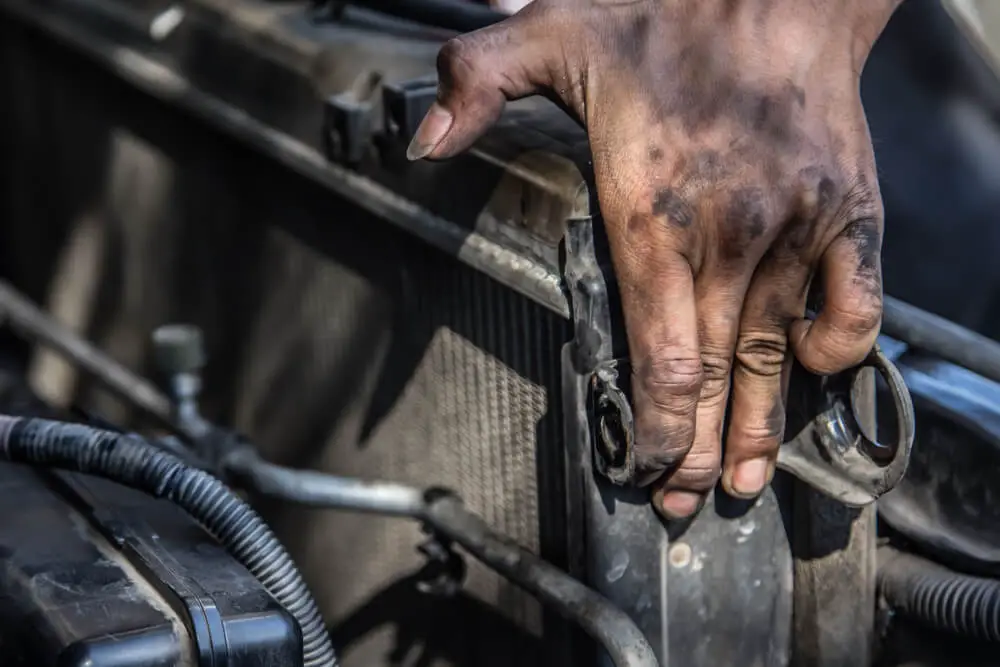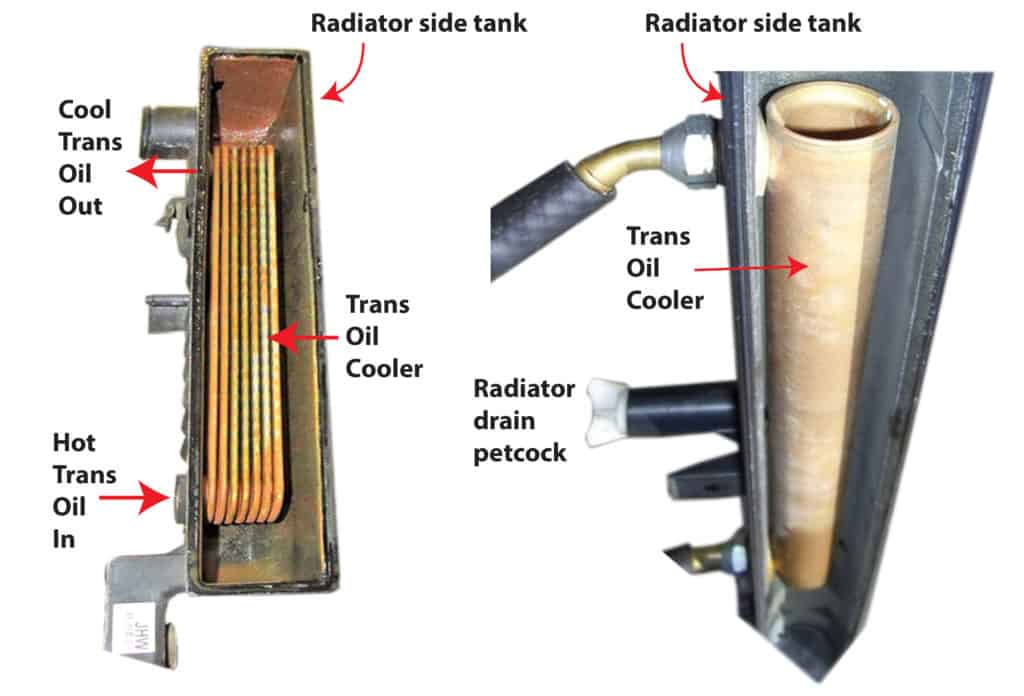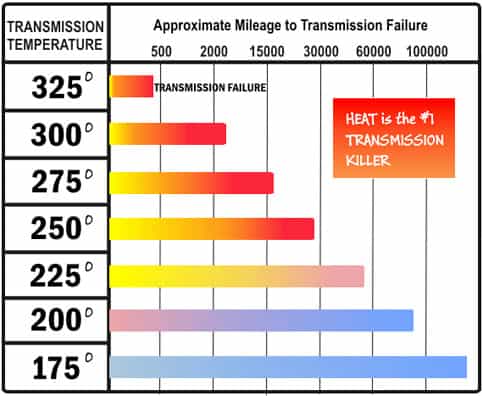Can a Bad Radiator Cause Transmission Problems?


This article will examine how radiators can cause transmission problems, how cracked radiators affect the transmission, signs of cracked radiators, and more.
Can A Bad Radiator Cause Transmission Problems?
A bad radiator could cause transmission problems in your car. The transmission system, just like your car’s engine, generates a large amount of heat. This heat increases the temperature of the transmission fluid that circulates through the transmission system.
The ideal or optimal temperature range for the transmission fluid is 175° to 220° degrees. Anything above this could damage parts of the transmission system.
An overheated transmission fluid could cause seal hardening, carbon formation, clutch burnout, and complete transmission failure.
Furthermore, a transmission cooler is employed by the manufacturer as a means to cool down the transmission fluid. The fluid passes through the cooler and comes in contact with ranges of plates or fins. In the cooler, the liquid is cooled and flows back to the transmission.
You can find the transmission cooler inside the radiator of your vehicle. Once something is wrong with the radiator, the transmission cooler is affected directly, and the fluid remains hot. It could cause severe damage to the transmission system. Thus, a defective radiator is responsible for transmission system problems.
How Does A Cracked Radiator Affect The Transmission?
A broken radiator will create an opening resulting in transmission fluid leaking from the radiator. When the coolant leaks, it could get mixed with transmission fluid. Once you have coolant in transmission fluid, it circulates back into the transmission.
Transmission fluids and coolants are entirely different and should not come in contact with each other. Transmission fluid is oil-based, and coolants are water-based. They are made from various components, and both fluids perform different tasks.
In addition, once coolants can get into the transmission because it is water-based, it erodes their metal parts. It will also neutralize essential additives in the transmission fluid.
Furthermore, a busted radiator will let out coolant faster from the radiator. As the coolant leaks, there is no longer enough to create the perfect environment in the cooler to cool the transmission fluid.
When driving with a cracked radiator, you face two transmission-related problems. The first problem is the coolant in the transmission fluid flowing back into the system. And, you have an overheated transmission fluid due to a failed radiator.
Signs of Cracked Radiator
A cracked car radiator comes with different signs which are easy to pinpoint. Some signs of a radiator damageddue to cracks included the following.
1. Coolants leak
You should know that where there are cracks, leaks will be present. Cracks in the radiator will create an opening for coolants to leak out. You will be able to see leaked coolant in exhaust or dropped on the floor.
Coolants are usually yellow, blue, or green to differentiate coolant leaks from other car fluids.
2. Sludge build-up
When you have cracks in the radiator, it will affect the condition of the coolant. The gap allows foreign substances into the coolants. It could weaken the barrier between the coolant and transmission, which will eventually fail. It will get coolant in transmission, causing sludge build-up.
3. Overheating
If you notice that you constantly have an overheated engine, this could mean that you have a cracked or blown radiator. Cracks in the radiator significantly hinder the quantity and quality of coolant that the engine gets.
The cracks leak coolant from the radiator and do not allow enough to get to the engine. It causes the engine and other essential parts of the vehicle to overheat.
4. Low coolants
The cracks in the radiator create a leak that constantly drains the radiator of coolants. It leaves your vehicle with a constant low coolant level.
If you notice that your vehicle consumes a lot of coolant, you must have the radiator checked for cracks and other leaks.
Coolant can last for a long time. The change interval for coolants is usually every 30,000 miles. In some vehicles, the recommended change interval could be 60,000 miles for the first change and then 30,000 miles for subsequent changes.
5. Triggered check engine light
The check engine light will come on due to the engine’s condition. Due to the engine not receiving enough coolant, heat builds up, which can trigger the check engine light. The heat can also damage parts of the engine which could also keep the check engine light on even when the engine has cooled down.
6. High-temperature gauge
The temperature gauge has the sole purpose of showing the temperature of the coolant. When there is a crack, the engine coolants will most likely have a high temperature because it could be contaminated or insufficient.
A temperature gauge in the vehicle will always read high when there is a crack in the radiator.
7. Rust
Rust is another sign of a cracked radiator. The opening on the radiator allows water to enter other radiator components, causing severe rust. You get this fixed as soon as possible.
Why Is There Transmission Fluid In My Radiator?
Internal cracks majorly cause transmission fluid in the radiator. As we know, the transmission fluid travels true to the radiator entering the transmission cooler to get cool.
A barrier separates the coolants in the radiator from the transmission fluid. Many factors could cause the barrier separating these fluids to crack. Some of these factors include.
1. Faulty thermostat
2. Leaking gasket
3. Low coolant level
Once the barrier separating the fluid fails, then there is a problem. Transmission fluid gets into coolants, and it flows through the engine. Also, the mixture of coolant and transmission fluid could escape to the transmission causing problems too.
Conclusion
Once you realize that a radiator is busted and experiencing some coolant in transmission damages, you must immediately fix the problem. Problems like this could seriously damage your engine and the transmission system. Solving the situation when the engine is affected will take a lot more.
I am Akindayini Temiloluwa, an automotive expert writer and car enthusiast. I have over three years of experience in the automotive writing niche and have completed over 300 pieces of content from 50 projects. I have vast knowledge and skill in vehicle repairing, all mechanical work, car upgrades and maintenance. My goal as an automotive content writer is to simplify the most challenging concepts for my readers, help them self-diagnose what may be wrong with their vehicles and offer real value for their time.
Recent Posts
One of the most common trouble codes that car owners might encounter is the P0420 code. Suppose you drive a Honda Accord and have the “Check Engine Light” illuminated on your dashboard with a.
Cars have become an integral part of our daily lives, providing convenience and mobility. However, every vehicle owner is familiar with the occasional hiccups that can disrupt the smooth operation of.
About Us
vehiclefixing.com is an automotive blog website that provides the latest and genuine technical information, repair, and maintenance advice to car owners and mechanics for their vehicles. We share our practical knowledge here to keep your cars in good condition and answer all your technical questions.
Can The Radiator Cause Transmission Cooling Problems?
The radiator is a crucial component of a vehicle’s cooling system, as it is responsible for regulating the temperature of the engine and transmission. In most automatic transmission equipped vehicles, the transmission cooler is located inside the radiator, which means that the radiator plays a crucial role in maintaining the transmission’s optimal operating temperature, so can the radiator cause transmission cooling problems?

If the radiator is not functioning properly, it can lead to a range of transmission problems such as:
- Transmission fluid overheating
- Fluid breakdown and deterioration
- Mixing of coolant and transmission fluid in radiator
- Contaminated transmission fluid
When the radiator fails to adequately cool the transmission, the transmission fluid can become overheated. This can cause the fluid to break down and become less effective at lubricating and cooling the transmission components.
Overheated transmission fluid can cause the transmission to experience a loss of power, as the fluid’s viscosity decreases and it becomes less able to transfer power from the engine to the transmission. This can lead to a noticeable reduction in the vehicle’s performance, as the transmission struggles to engage and shift gears.
In severe cases, overheated transmission fluid can cause the transmission to fail completely. The heat can cause the transmission’s internal components to warp and distort, leading to significant damage and the need for costly repairs or replacement. The below chart shows how long you can expect a transmission to last at a certain temperature.

In addition to overheating, a faulty radiator can also lead to the transmission fluid becoming contaminated. If the radiator is leaking or has developed a clog, it can allow coolant to mix with the transmission fluid. This can cause the transmission fluid to become contaminated, reducing its effectiveness and leading to transmission problems.
In some cases, a faulty radiator can also cause the transmission to experience a loss of pressure. The radiator is responsible for maintaining the correct level of transmission fluid, and if the radiator is not functioning properly, the transmission may not receive the correct amount of fluid. This can cause the transmission to lose pressure, leading to problems with shifting and other performance issues.
To prevent the radiator from causing transmission problems, it is essential to maintain the radiator and ensure that it is functioning correctly. This includes regularly checking the radiator for leaks and clogs, and replacing the radiator if it is damaged or faulty. Additionally, it is essential to use the correct type of transmission fluid and change it at the recommended intervals to ensure that the transmission is adequately lubricated and cooled.
In summary, the radiator can cause transmission problems if it is not functioning correctly. A faulty radiator can lead to overheated transmission fluid, contaminated transmission fluid, and a loss of pressure, all of which can cause significant damage to the transmission and lead to costly repairs or replacement. By maintaining the radiator and ensuring that it is functioning correctly, it is possible to prevent these problems and keep the transmission in optimal working condition.
Frequently Asked Questions (FAQs)
Can low coolant cause transmission problems?
Yes, low coolant levels in a vehicle can cause transmission problems for several reasons. First, the transmission relies on the vehicle’s cooling system to regulate its temperature and prevent overheating. When the coolant levels are low, the transmission may not receive adequate cooling, leading to overheating and potential damage to the transmission’s internal components.
Can a clogged radiator cause transmission problems?
Yes, a clogged radiator will not be able to effectively dissipate heat from the engine and transmission. This can cause the transmission fluid to overheat, leading to a loss of lubrication and increased wear on the transmission components. Overheated transmission fluid can also cause the transmission to shift harshly or even fail to shift at all.
Can a radiator leak cause transmission problems?
A radiator leak can cause transmission problems in a few different ways. Firstly, a radiator leak can cause the transmission fluid to become contaminated with coolant. This can cause the transmission fluid to become less effective at lubricating and cooling the transmission, leading to premature wear and potentially damaging the transmission.
Secondly, a radiator leak can cause the transmission to overheat. The transmission relies on the radiator to keep it cool, and if the radiator is leaking, the transmission may not be receiving enough coolant to keep it at a safe operating temperature. This can cause the transmission to fail, resulting in a loss of power and potentially requiring costly repairs.
Thirdly, a radiator leak can also cause a lack of coolant pressure in the system. The transmission relies on a certain level of coolant pressure to operate properly, and if the radiator is leaking, the coolant pressure may drop below the required level. This can cause the transmission to malfunction and potentially fail.
https://vehiclefixing.com/bad-radiator-cause-transmission-problems/https://transmissioncoolerguide.com/transmission-coolers/can-the-radiator-cause-transmission-cooling-problems/

